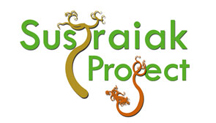Drexel H. Foundation Project: Rest, Repair, Recharge & Rejuvenate in Downtown Vale
Ontario Basque Club is proud to participate in the Drexel H. Foundation's project by providing historical perspective on Basques in the area. Rest, Repair, Recharge & Rejuvenate in Downtown Vale on the authentic Oregon Trail Project. It benefits our rural pioneer community, visitors, and Oregon with a bicycle & skate repair station, EV charging station, an outdoor resting place with free wi-fi, and public bathrooms at the 1895 Grand Opera House.It features Informative panels, Maps & scan codes for self -guided bike-walking tours of Vales Historic buildings, Murals and public art, with historic photos of the places they are viewing, heritage stories, and information about these local assets.
The text of the informative panel on Basques is reproduced here with links to further information.
Celebrating Basque Families who shaped our Community
THE BASQUE HOMELAND, Euskal Herria, straddles the modern states of Spain and France, but existed long before this area was divided into countries. Euskara, the ancient indigenous language of the Basque people, is not related to any other language in the world. It bears no resemblance to the languages of its surrounding neighbors which are based on Latin developed in the region in post-Roman times. Euskara is the only pre-Roman language that survives in continental Europe today. Hori ikaragarria da! (That is amazing!)
BASQUE IMMIGRATION leading to the formation of Basque communities in the western United States began at the time of the California gold rush. Many centuries before, however, Basques had left their mark on North America as early explorers and missionaries in the south and west, and whalers on the east coast as early as the fifteenth century. Basque immigration to Eastern Oregon and the Treasure Valley began in earnest in the last decade of the 19th century. Two industrious twenty-one-year-old Basques who began their American experience as sheepherders in Nevada took their savings and made a harrowing journey across the desert to Jordan Valley in 1889. Antonio Azcuenaga and Jose Navarro settled there and became successful entrepreneurs and sheepmen. This was the beginning of the Basque
community of Eastern Oregon. By 1900 there were 38 Basques residing in Malheur County, including one woman. By 1920 this number grew to 424. The Harney County census showed no Basques in 1900, but by 1910 there was a presence that grew to 70 Basques in 1920. According to the U.S. census, there were 2,627 People of Basque descent in Oregon in 2000.
SHEEPHERDING became the main occupation of early Basque immigrants. Most of the young Basque men who made their way to Oregon were from small rural farmsteads along the coast of Bizkaia. Fewer were from Gipuzkoa, Nafarroa, and inland Bizkaia. Only a handful were from the remaining territories of the homeland. Most were from seafaring families and had little experience with sheep, especially not with the form it took in the American west with very large flocks and a very different pattern of transhumance. They were simply filling a niche in the labor market that was accessible to hard workers with little or no English. Most planned to save their wages and return to the homeland, but many stayed, started families, and laid the foundation of our present-day Basque Community.
Oregon, pronounced in Basque sounds like the phrase, "hor egon" which translates to "stay there." Many Basques did, indeed, stay in the state.
BASQUE BOARDING HOUSES were established to house herders during seasons in which the sheep were trailed down to the valleys. Female immigrants often found
employment and sometimes husbands in these communal gathering spaces where they cooked familiar food, heard their native language, danced, and sang. Some of the women who ran these establishments had first joined their husbands in sheep camp, cooking to feed the herders. Some of the first boarding houses were in Jordan Valley. Here in Vale, the Unamuno family opened a Basque hotel in 1912. The Urizars opened the Star Hotel in Burns in 1926. There were also Basque boarding houses in Crane, and another near the Steens Mountains owned by the Arreguis. The Echanis Boarding House opened in Ontario in 1922. It was a popular meeting place for Basques for many decades. By the 1970s the era of the Basque boarding house had virtually come to a close.
A NEW ERA began as grazing laws and other factors saw a decline in Basque involvement in the sheep industry. Although there are Basque-Americans who still raise sheep, most children and grandchildren of immigrants have taken other paths available
to them due to the educationalaaa opportunities they had been afforded. However, a desire to maintain traditions like dancing, rural sports, card games, and language led to the creation of groups like Ontario Basque Club. This club, founded in 1947, remains actively involved in fund-raising for local charities. A federation of Basque associations in the United States and Canada was founded in 1973 with the name North American Basque Organizations, Inc.







